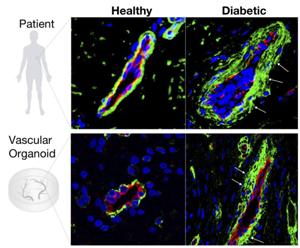Perfect human blood vessels as organoids grown in petri-dish for the first time
 Scientists have grown perfect human blood vessels as organoids in a petri-dish, for the first time. The research of vascular diseases like diabetes has been drastically advanced by Institute for Molecular Biotechnology of the Austrian Academy of Sciences (IMBA)’s breakthrough engineering technology published in Nature, identifying a key pathway to possibly prevent changes to blood vessels, which is a major cause of death among people with diabetes. An organoid is a three-dimensional structure grown from stem cells. A blood vessel organoid mimics the structure and function of real human blood vessels and can be used to study their characteristics in a petri-dish.
Scientists have grown perfect human blood vessels as organoids in a petri-dish, for the first time. The research of vascular diseases like diabetes has been drastically advanced by Institute for Molecular Biotechnology of the Austrian Academy of Sciences (IMBA)’s breakthrough engineering technology published in Nature, identifying a key pathway to possibly prevent changes to blood vessels, which is a major cause of death among people with diabetes. An organoid is a three-dimensional structure grown from stem cells. A blood vessel organoid mimics the structure and function of real human blood vessels and can be used to study their characteristics in a petri-dish.
Every single organ in human body is connected with the circulatory system. This technology could potentially allow scientists to reveal the causes and treatments for a number of vascular diseases, such as Alzheimer's, cardiovascular diseases, wound healing problems, stroke, cancer, and diabetes.
An estimated 420 million people are affected by diabetes worldwide. Several symptoms of diabetes present because of changes in blood vessels that result in impaired blood circulation and oxygen supply to tissues. Despite its prevalence, as very little is known about the vascular changes arising from diabetes, the development of much-needed treatment has been slowed down.
The blood vessel organoids developed into perfectly functional human blood vessels including arteries and capillaries, when transplanted into mice. So the scientists have discovered that not only it is possible to engineer blood vessel organoids from human stem cells in a dish, but also to grow a functional human vascular system in another species.
According to Reiner Wimmer, the study's first author and a postdoctoral research fellow at IMBA, these organoids resembled human capillaries to a great extent, even on a molecular level, and these could now be used to study blood vessel diseases directly on human tissue.
One feature of diabetes is that blood vessels show an abnormal thickening of the basement membrane which impairs the delivery of oxygen and nutrients to cells and tissues causing a multitude of health problems, such as heart attacks, strokes, blindness, kidney failure, and peripheral artery disease.
When the scientists exposed the blood vessel organoids to a "diabetic" environment in a petri-dish, they observed a massive expansion of the basement membrane in the vascular organoids, which was strikingly similar to the vascular damage seen in patients with diabetes.
“The researchers then searched for chemical compounds that could block thickening of the blood vessel walls. They found none of the current anti-diabetic medications had any positive effects on these blood vessel defects. However, they discovered that an inhibitor of ?-secretase, a type of enzyme in the body, prevented the thickening of the blood vessel walls, suggesting, at least in animal models, that blocking ?-secretase could be helpful in treating diabetes,” said Wimmer. “The findings can allow the researchers to identify underlying causes of vascular disease, and to potentially develop and test new treatments for patients with diabetes,” he added.
To know more about the latest update on this treatment protocol and treating centers offering the same as well as
for getting your reports reviewed, post a query
